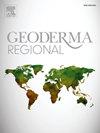如何对草地进行选址,有效减少农业水土流失?芬兰的计算分析
IF 3.1
2区 农林科学
Q2 SOIL SCIENCE
引用次数: 0
摘要
土地覆盖和农业经营的空间格局对土壤侵蚀有明显的影响。在水土流失防治中,分配一定面积的耕地种草是一种广泛应用的策略。然而,在不同的景观中,为了有效地控制侵蚀,在空间上应该有多少和在哪里有针对性地种植草地,目前还不清楚。为了应对这一挑战,我们估计了基于rusle的高分辨率草地空间定位的潜力,以改善芬兰南部两个地形不同的集水区的侵蚀缓解。将1)基于政策的目标(根据当前CAP战略沿主要河流的缓冲带)与2)基于rusle目标的草地(基于田间地块和子集水区的最高计算侵蚀值)进行了比较。此外,我们通过计算探索了3)不同的最佳定位草地面积对侵蚀的影响以及4)如何将这些区域计算处理为连续实体。利用2 × 2 m2分辨率RUSLE计算估算了所有情景下的侵蚀减少量。与基于政策的沿河岸草地选址相比,rusle目标草地显示出更大的侵蚀减少。通过优化定位,与缓冲带相比,侵蚀风险可降低24个百分点(最多可降低46%)。从0到100%逐渐增加最佳目标草地面积,侵蚀呈非线性减少。最大比例的侵蚀发生在不成比例的小土地面积(约占土地面积的20%)。热点相对于溪流的位置在子集水区和田间地块之间有所不同。这些量化结果显示了模型在有针对性的景观尺度空间侵蚀管理中的潜在价值。改进经验验证和考虑侵蚀和泥沙运输的其他方面,如当地排水效率和河流泛滥期间侵蚀的减少,将有利于对减缓侵蚀进行更全面的评估。本文章由计算机程序翻译,如有差异,请以英文原文为准。
How to site grassed areas to reduce agricultural erosion efficiently? A computational analysis in Finland
Spatial patterns of land-cover and agricultural operations have clear impacts on soil erosion. Allocating a portion of cultivated area for grass is a widely applied strategy to control erosion. However, it is still unclear how much and where grassed area should be spatially targeted in different landscapes to control erosion efficiently. To address this challenge, we estimate the potential of high-resolution RUSLE-based spatial targeting of grassed areas to improve erosion mitigation in two topographically different catchments in southern Finland. Erosion reductions of 1) policy-based targeting (buffer strips along main streams according to current CAP strategy) were compared with 2) RUSLE-targeted grassed areas (based on the highest computed erosion values within field parcels and sub-catchments). Furthermore, we computationally explored 3) how different rates of optimally located grass areas affected erosion and 4) how the areas could be computationally processed to continuous entities. The erosion reductions were estimated with 2 × 2 m2 resolution RUSLE computations in all the scenarios. The RUSLE-targeted grassed areas demonstrated greater erosion reductions compared to the policy-based siting of grass areas along riparian fields. With optimal targeting, erosion risks could potentially be reduced up to 24 percentage points (up to 46 % erosion reduction), compared to the buffer strips. Increasing optimally targeted grassed area gradually from 0 to 100 % decreased erosion non-linearly. The largest share of erosion was generated in disproportionally small land areas (∼20 % of the land area). The location of the hotspots in relation to the streams varied between the sub-catchments and field parcels. These quantifications demonstrate the potential value of models for targeted landscape scale spatial erosion management. A more comprehensive assessment of erosion mitigation could benefit of improved empirical validation and consideration of other aspects of erosion and sediment transport, such as local drainage efficiency and reduction of erosion during flooding of rivers.
求助全文
通过发布文献求助,成功后即可免费获取论文全文。
去求助
来源期刊

Geoderma Regional
Agricultural and Biological Sciences-Soil Science
CiteScore
6.10
自引率
7.30%
发文量
122
审稿时长
76 days
期刊介绍:
Global issues require studies and solutions on national and regional levels. Geoderma Regional focuses on studies that increase understanding and advance our scientific knowledge of soils in all regions of the world. The journal embraces every aspect of soil science and welcomes reviews of regional progress.
 求助内容:
求助内容: 应助结果提醒方式:
应助结果提醒方式:


